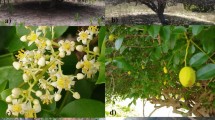Abstract
Chinese pine, Pinus tabulaeformis Carr., a species that ranges broadly across northeastern to southwestern China, plays a vital role in the maintenance of the structure and function of these ecosystems. In this study, we examined the genetic diversity of five widespread populations in Shanxi Plateau, the distribution center of Chinese pine, using 15 random amplified polymorphic DNA (RAPD) primers and five inter simple sequence repeat (ISSR) primers in 140 individual tree samples. Similar genetic differentiation results were obtained from the data of RAPD and ISSR. Based on the two sets of data, Nei’s genetic diversity was 0.2842 and 0.3078 and Shannon’s indices of diversity were 0.4332 and 0.4468. Genetic diversity at the species level was found high relative to that for other genera of Pinaceae. The greatest diversity was observed in the Lingkong Mountain population (0.3860), while the lowest was recorded in the Luya Mountain population (0.3352), most likely as a result of natural adaptation and anthropogenic perturbation. The relative magnitude of differentiation among populations (G ST) was 0.1491 and 0.1356, respectively, implying that most genetic variation was within the populations (∼0.8509), rather than among populations.
Similar content being viewed by others
References
Aagaard, J.E., Krutovskii, K.V., and Strauss, S.H., RAPDs and Allozymes Exhibit Similar Levels of Diversity and Differentiation among Populations and Races of Douglas Fir, Heredity, 1998, vol. 81, pp. 69–78.
Aranzazu, G., Ricardo, A., and Maria, A.B., Genetic Diversity of Pinus halepensis Mill. Populations Detected by RAPD Loci, Ann. Forest Sci., 2001, vol. 58, pp. 869–875.
Cullings, K.W., Design and Testing of a Plant-Specific PCR Primer for Ecological and Evolutionary Studies, Mol. Ecol., 1992, vol. 1, pp. 233–240.
Doyle, J.J. and Doyle, J.L., A Rapid DNA Isolation Procedure for Small Quantities of Fresh Leaf Tissue, Phytochem. Bull., 1987, vol. 19, pp. 11–15.
Hamrick, J.L., Godt, M.J.W., and Sherman-Broyles, S.L., Factors Influencing Levels of Genetic Diversity in Woody Plant Species, New Forests, 1992, vol. 6, pp. 95–124.
Jørgensen, S., Hamrick, J.L., and Wells, P.V., Regional Patterns of Genetic Diversity in Pinus flexilis (Pinaceae) Reveal Complex Species History, Am. J. Bot., 2002, vol. 89, no. 5, pp. 792–800.
Kandedmir, G.E., Kandedmir, I., and Kaya, Z., Genetic Variation in Turkish Red Pine (Pinus brutid) Seed Stands As Determined by RAPS Marker, Sivae Genet., 2004, vol. 53, no. 4, pp. 169–175.
Li, Y. and Zhang, C.X., Genetic Diversity within a Breeding System of Pinus tabulaeformis, J. Beijing Forestry Univ., 2000, vol. 22, pp. 12–19.
Li, C., Chai, B.F., and Wang, M.B., Genetic Diversity of Population of Chinese Pine (Pinus tabulaeformis Carr.) in Shanxi Plateau, Ecol. Environ., 2005, vol. 14, pp. 719–722.
Liu, G.F., Dong, J.X., Jiang, Y., et al., Analysis of Genetic Relationship in 12 Species of Section Strobus with ISSR Markers, J. Forest. Res., 2005, vol. 16, no. 3, pp. 213–215.
Nei, M., Estamation of Average Heterozygosity and Genetic Distance from a Small Number of Individuals, Genetics, 1978, vol. 89, pp. 583–590.
Oleksyn, J., Prus-Glowacki, W., Giertych, M., and Reich, P.B., Relation between Genetic Diversity and Pollution Impact in a 1912 Experiment with East European Pinus sylvestris Provenances, Can. J. Forest Res., 1994, vol. 24, pp. 2390–2394.
Powell, W., Morgante, M., McDevitt, R., et al., Polymorphic Simple Sequence Repeat Regions on Chloroplast Genomics Application to the Population Genetics of Pines, Proc. Natl. Acad. Sci. USA, 1995, vol. 92, pp. 7759–7763.
Raddi, S., Stefanini, P.M., Camussi, A., and Giannini, R., Forest Decline Index and Genetic Variability in Picea abies (L.) Karst., Forest Genet., 1994, vol. 1, pp. 33–40.
Tani, N., Maruyama, K., Tomaru, N., et al., Genetic Diversity of Nuclear and Mitochondrial Genomes in Pinus parviflora Sieb. & Zucc. (Pinaceae) Populations, Heredity, 2003, vol. 91, pp. 510–518.
Xu, H.C., Geographic Variation and Provenance Selection of Pinus tabulaeformis Gait, China, Beijing: Forest Press, 1991.
Yeh, F.C., Yang, R.C., and Boyle, T., POPGENE Version 1.31: Microsoft Windows-Based Freeware for Population Genetic Analysis, Edmonton: Univ. of Alberta Press, 1999.
Author information
Authors and Affiliations
Corresponding author
Additional information
Published in Russian in Ekologiya, 2008, No. 1, pp. 36–42.
The article was translated by the authors.
Rights and permissions
About this article
Cite this article
Li, C., Chai, B. & Wang, M. Population genetic structure of Pinus tabulaeformis in Shanxi Plateau, China. Russ J Ecol 39, 34–40 (2008). https://doi.org/10.1134/S1067413608010062
Received:
Published:
Issue Date:
DOI: https://doi.org/10.1134/S1067413608010062




